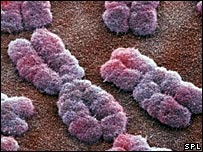Scientists discovered the gene that causes autism after learning in a large number of people who have never done families with many people in this case. They studied 120 people from 50 different scientific research institutes in 19 countries, tracking 1,200 families.

Chromosome 11 is considered the culprit
The study was published in the genetics Nature Genetics, showing that the culprit is an area on chromosome 11 and a special gene called neurexin 1. Experts say the discovery could help find materials. New method to treat autism.
Autism is a complex neurological disease that interferes with communication ability, the ability to build relationships in society, and often comes with extreme attitudes or behaviors.
Scientists have long suspected that the wrongs in genes contribute to autism. Genetic code, DNA, consists of many cells in chromosome pairs containing genes. Experts now identify an area on chromosome 11 and a special gene called neurexin 1. Neurexin belongs to a line of genes responsible for helping neurons communicate with each other and scientists believe it plays an important role in autism.
The study began in 2002 when scientists created the Autism Genome Project funded by Autism Speaks and the US National Institutes of Health. They use advanced technology to find genetic similarities in people with autism.
Typical autistic attitude
Inability to make friends with other children.
Inability to talk to others.
Lack of, or inability to imagine or sociable, social activities.
Repeat, or use words, unusual sentences.
Do not care and show interest.
Busy with an object or something of your own.
Rigid, without flexibility to suit the situation.
American Psychiatric Association
Future therapy
Pediatric neurologist, Professor Jonathan Green, who leads the clinical research section in Manchester, said: "Autism is a challenge for families because they can't communicate with their children, which is a natural ability has. "
"We hope these interesting research results can be a step on the way to new therapies to treat autism in the future."
Professor John Burn, of Newcastle University's Institute of Human Genetics Research, also expressed his joy at the news.
But he cautioned people to say, "It is almost certain that there must be an effect between many genes, so this discovery has not yet yielded a comprehensive answer and may not lead to finding a way to test genes but it can be an important step on the way to finding effective therapies because it gives us the goal to make drugs. "
Dr Fred Kavalier of the British Society for Human Genetics is also cautious that finding a cure for autism is a long way.
Professor Simon Baron-Cohen, director of the University of Cambridge Autism Research Center, said similar independent results are needed.
The next phase of the study will last for 3 years and cost more than £ 7 million, to delve into the identified area of DNA. It is estimated that autism and related conditions affect 1 in 100 children in the UK.

 Green tea cleans teeth better than mouthwash?
Green tea cleans teeth better than mouthwash? Death kiss: This is why you should not let anyone kiss your baby's lips
Death kiss: This is why you should not let anyone kiss your baby's lips What is salmonellosis?
What is salmonellosis? Caution should be exercised when using aloe vera through eating and drinking
Caution should be exercised when using aloe vera through eating and drinking